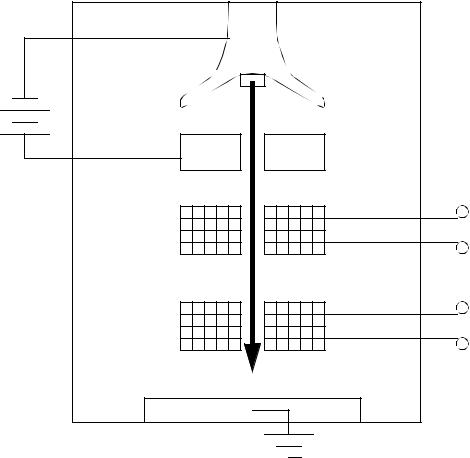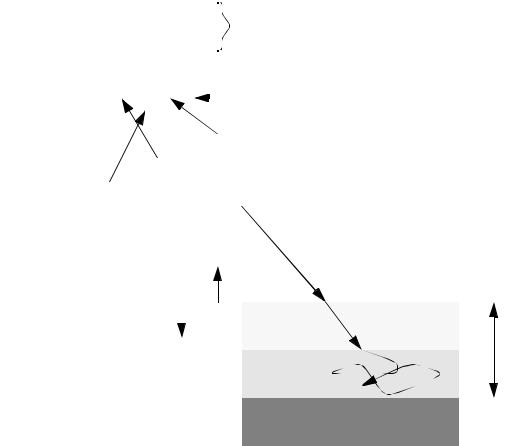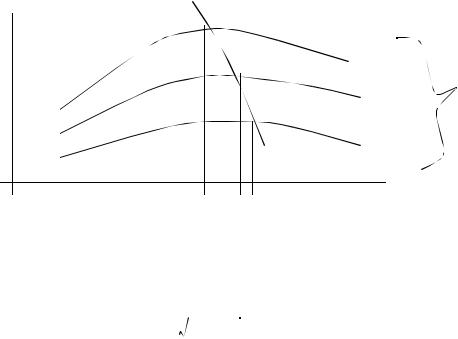
- •1. TABLE OF CONTENTS
- •2. BASIC MANUFACTURING
- •2.1 INTRODUCTION
- •2.2 PRACTICE PROBLEMS
- •3. MANUFACTURING COST ESTIMATING
- •3.1 COSTS ESTIMATES
- •3.2 COGS (COST OF GOODS SOLD)
- •3.3 VALUE ENGINEERING
- •3.4 REFERENCES
- •4. BASIC CUTTING TOOLS
- •4.1 CUTTING SPEEDS, FEEDS, TOOLS AND TIMES
- •4.2 HIGH SPEED MACHINING
- •4.3 REFERENCES
- •5. CUTTING THEORY
- •5.1 CHIP FORMATION
- •5.2 THE MECHANISM OF CUTTING
- •5.2.1 Force Calculations
- •5.2.1.1 - Force Calculations
- •5.2.1.2 - Merchant’s Force Circle With Drafting (Optional)
- •5.3 POWER CONSUMED IN CUTTING
- •5.4 PRACTICE QUESTIONS
- •5.5 TEMPERATURES IN CUTTING
- •5.6 TOOL WEAR
- •5.7 CUTTING TOOL MATERIALS
- •5.7.1 A Short List of Tool Materials
- •5.8 TOOL LIFE
- •5.8.1 The Economics of Metal Cutting
- •5.9 REFERENCES
- •5.10 PRACTICE PROBLEMS
- •6. SAWS
- •6.1 SPEEDS AND FEEDS
- •6.2 PRACTICE PROBLEMS
- •7. DRILLING
- •7.1 TYPES OF DRILL PRESSES
- •7.2 TYPICAL DRILL PRESS OPERATIONS
- •7.3 TYPICAL DRILL BITS
- •7.3.1 Reamers
- •7.3.2 Boring
- •7.3.3 Taps
- •7.4 DRILLING PROCESS PARAMETERS
- •7.4.1 The mrr For Drilling
- •7.5 PRACTICE PROBLEMS
- •8. LATHES
- •8.1 INTRODUCTION
- •8.2 OPERATIONS ON A LATHE
- •8.2.1 Machine tools
- •8.2.1.1 - Production Machines
- •8.3 LATHE TOOLBITS
- •8.3.1 Thread Cutting On A Lathe
- •8.3.2 Cutting Tapers
- •8.3.3 Turning Tapers on Lathes
- •8.4 FEEDS AND SPEEDS
- •8.4.1 The mrr for Turning
- •8.4.2 Process Planning for Turning
- •8.5 PRACTICE PROBLEMS
- •9. MILLING
- •9.1 INTRODUCTION
- •9.1.1 Types of Milling Operations
- •9.1.1.1 - Arbor Milling
- •9.1.2 Milling Cutters
- •9.1.3 Milling Cutting Mechanism
- •9.1.3.1 - Up-Cut Milling
- •9.1.3.2 - Down-Cut Milling
- •9.2 FEEDS AND SPEEDS
- •9.2.1 The mrr for Milling
- •9.2.2 Process Planning for Prismatic Parts
- •9.2.3 Indexing
- •9.3 PRACTICE PROBLEMS
- •10. GRINDING
- •10.1 OPERATIONS
- •10.2 MACHINE TYPES
- •10.2.1 Surface
- •10.2.2 Center
- •10.2.3 Centerless
- •10.2.4 Internal
- •10.3 GRINDING WHEELS
- •10.3.1 Operation Parameters
- •10.4 PRACTICE PROBLEMS
- •11. SURFACES
- •11.1 MEASURES OF ROUGHNESS
- •11.2 METHODS OF MEASURING SURFACE ROUGHNESS
- •11.2.1 Observation Methods
- •11.2.2 Stylus Equipment
- •11.2.3 Specifications on Drawings
- •11.3 OTHER SYSTEMS
- •11.4 PRACTICE PROBLEMS
- •11.4.0.1 - Roundness Testing
- •11.4.0.1.1 - Intrinsic Roundness Testing
- •11.4.0.1.2 - Extrinsic Roundness Testing
- •11.4.0.1.3 - Practice Problems
- •11.5 PRACTICE PROBLEMS
- •35. METROLOGY
- •35.1 INTRODUCTION
- •35.1.1 The Role of Metrology
- •35.2 DEFINITIONS
- •35.3 STANDARDS
- •35.3.1 Scales
- •35.3.2 Calipers
- •35.3.3 Transfer Gauges
- •35.4 INSTRUMENTS
- •35.4.1 Vernier Scales
- •35.4.2 Micrometer Scales
- •35.4.2.1 - The Principle of Magnification
- •35.4.2.2 - The Principle of Alignment
- •35.4.3 Dial Indicators
- •35.4.4 The Tool Makers Microscope
- •35.4.5 Metrology Summary
- •35.5 PRACTICE PROBLEMS
- •35.5.0.1 - Interferometry (REWORK)
- •35.5.0.1.1 - Light Waves and Interference
- •35.5.0.1.2 - Optical Flats
- •35.5.0.1.3 - Interpreting Interference Patterns
- •35.5.0.1.4 - Types of Interferometers
- •35.5.0.2 - Laser Measurements of Relative Distance
- •35.5.0.2.1 - Practice Problems
- •35.6 GAUGE BLOCKS
- •35.6.1 Manufacturing Gauge Blocks
- •35.6.2 Compensating for Temperature Variations
- •35.6.2.1 - References
- •35.6.3 Testing For Known Dimensions With Standards
- •35.6.3.1 - References
- •35.6.4 Odd Topics
- •35.6.5 Practice Problems
- •35.6.6 Limit (GO & NO GO) Gauges
- •35.6.6.1 - Basic Concepts
- •35.6.6.2 - GO & NO GO Gauges Using Gauge Blocks
- •35.6.6.3 - Taylor’s Theory for Limit Gauge Design
- •35.6.6.4.1 - Sample Problems
- •35.6.7 Sine Bars
- •35.6.7.1 - Sine Bar Limitations
- •35.6.7.1.1 - Practice Problems
- •35.6.8 Comparators
- •35.6.8.1 - Mechanical Comparators
- •35.6.8.2 - Mechanical and Optical Comparators
- •35.6.8.3 - Optical Comparators
- •35.6.8.4 - Pneumatic Comparators
- •35.6.9 Autocollimators
- •35.6.10 Level Gauges
- •35.6.10.1 - Clinometer
- •35.6.10.2 - The Brookes Level Comparator
- •35.6.11 The Angle Dekkor
- •35.7 MEASURING APARATUS
- •35.7.1 Reference Planes
- •35.7.1.1 - Granite Surface Plates
- •35.7.1.2 - Cast Iron Surface Plates
- •35.7.2 Squares
- •35.7.2.1 - Coordinate Measureing Machines
- •35.7.2.2 - Practice Problems
- •AM:35.7.3 Coordinate Measuring Machines (CMM)
- •36. ASSEMBLY
- •36.1 THE BASICS OF FITS
- •36.1.1 Clearance Fits
- •36.1.2 Transitional Fits
- •36.1.3 Interference Fits
- •36.2 C.S.A. B97-1 1963 LIMITS AND FITS(REWORK)
- •36.3 CSA MODIFIED FITS
- •36.4 CSA LIMITS AND FITS
- •36.5 THE I.S.O. SYSTEM
- •36.6 PRACTICE PROBLEMS
- •42. WELDING/SOLDERING/BRAZING
- •42.1 ADHESIVE BONDING
- •42.2 ARC WELDING
- •42.3 GAS WELDING
- •42.4 SOLDERING AND BRAZING
- •42.5 TITANIUM WELDING
- •42.5.1 Practice Problems
- •42.6 PLASTIC WELDING
- •42.7 EXPLOSIVE WELDING
- •42.7.1 Practice Problems
- •43. AESTHETIC FINISHING
- •43.1 CLEANING AND DEGREASING
- •43.2 PAINTING
- •43.2.1 Powder Coating
- •43.3 COATINGS
- •43.4 MARKING
- •43.4.1 Laser Marking
- •43.5 PRACTICE PROBLEMS
- •44. METALLURGICAL TREATMENTS
- •44.1 HEAT TREATING
- •44.2 ION NITRIDING
- •44.3 PRACTICE PROBLEMS
- •45. CASTING
- •45.1 SAND CASTING
- •45.1.1 Molds
- •45.1.2 Sands
- •45.2 SINGLE USE MOLD TECHNIQUES
- •45.2.1 Shell Mold Casting
- •45.2.2 Lost Foam Casting (Expandable Pattern)
- •45.2.3 Plaster Mold Casting
- •45.2.4 Ceramic Mold Casting
- •45.2.5 Investment Casting
- •45.3 MULTIPLE USE MOLD TECHNIQUES
- •45.3.1 Vacuum Casting
- •45.3.2 Permanent Mold Casting
- •45.3.2.1 - Slush Casting
- •45.3.2.2 - Pressure Casting
- •45.3.2.3 - Die Casting
- •45.3.3 Centrifugal Casting
- •45.3.4 Casting/Forming Combinations
- •45.3.4.1 - Squeeze Casting
- •45.3.4.2 - Semisolid Metal Forming
- •45.3.5 Single Crystal Casting
- •45.4 OTHER TOPICS
- •45.4.1 Furnaces
- •45.4.2 Inspection of Casting
- •45.5 Design of Castings
- •45.6 REFERENECES
- •45.7 PRACTICE PROBLEMS
- •46. MOLDING
- •46.1 REACTION INJECTION MOLDING (RIM)
- •46.1.1 References
- •46.2 INJECTION MOLDING
- •46.2.1 Hydraulic Pumps/Systems
- •46.2.2 Molds
- •46.2.3 Materials
- •46.2.4 Glossary
- •46.3 EXTRUSION
- •46.4 PRACTICE PROBLEMS
- •47. ROLLING AND BENDING
- •47.1 BASIC THEORY
- •47.2 SHEET ROLLING
- •47.3 SHAPE ROLLING
- •47.4 BENDING
- •48. SHEET METAL FABRICATION
- •48.1 SHEET METAL PROPERTIES
- •48.2 SHEARING
- •48.2.1 Progressive and Transfer Dies
- •48.2.2 DRAWING
- •48.3 DEEP DRAWING
- •48.4 SPINNING
- •48.5 MAGNETIC PULSE FORMING
- •48.6 HYDROFORMING
- •48.7 SUPERPLASTIC FORMING
- •48.7.1 Diffusion Bonding
- •48.8 PRACTICE PROBLEMS
- •49. FORGING (to be expanded)
- •49.1 PROCESSES
- •49.1.1 Open-Die
- •49.1.2 Impression/Closed Die
- •49.1.3 Heading
- •49.1.4 Rotary Swaging
- •50. EXTRUSION AND DRAWING
- •50.1 DIE EXTRUSION
- •50.1.1 Hot Extrusion
- •50.1.2 Cold Extrusion
- •50.2 HYDROSTATIC EXTRUSION
- •50.3 DRAWING
- •50.4 EQUIPMENT
- •50.5 PRACTICE PROBLEMS
- •51. ELECTROFORMING
- •51.1 PRACTICE PROBLEMS
- •52. COMPOSITE MANUFACTURING
- •52.1 FIBER REINFORCED PLASTICS (FRP)
- •52.2 COMPOSITE MANUFACTURING
- •52.2.1 Manual Layup
- •52.2.2 Automated Tape Lamination
- •52.2.3 Cutting of Composites
- •52.2.4 Vacuum Bags
- •52.2.5 Autoclaves
- •52.2.6 Filament Winding
- •52.2.7 Pultrusion
- •52.2.8 Resin-Transfer Molding (RTM)
- •52.2.9 GENERAL INFORMATION
- •52.2.10 REFERENCES
- •52.2.11 PRACTICE PROBLEMS
- •53. POWDERED METALLURGY
- •53.1 PRACTICE PROBLEMS
- •54. ABRASIVE JET MACHINING (AJM)
- •54.1 REFERENCES
- •54.2 PRACTICE PROBLEMS
- •55. HIGH PRESSURE JET CUTTING
- •56. ABRASIVE WATERJET CUTTING (AWJ)
- •57. ULTRA SONIC MACHINING (USM)
- •57.1 REFERENCES
- •57.1.1 General Questions
- •58. ELECTRIC DISCHARGE MACHINING (EDM)
- •58.1 WIRE EDM
- •58.2 PRACTICE PROBLEMS
- •58.3 REFERENCES
- •59. ELECTROCHEMICAL MACHINING (ECM)
- •59.1 REFERENCES
- •59.2 PRACTICE PROBLEMS
- •60. ELECTRON BEAM MACHINING
- •60.1 REFERENCES
- •60.2 PRACTICE PROBLEMS
- •61. ION IMPLANTATION
- •61.1 THIN LAYER DEPOSITION
- •61.2 PRACTICE PROBLEMS
- •62. ELECTROSTATIC SPRAYING
- •62.1 ELECTROSTATIC ATOMIZATION METHOD
- •62.2 PRACTICE PROBLEMS
- •63. AIR-PLASMA CUTTING
- •63.1 REFERENCES
- •63.2 PRACTICE PROBLEMS
- •64. LASER CUTTING
- •64.1 LASERS
- •64.1.1 References
- •64.2 LASER CUTTING
- •64.2.1 References
- •64.3 PRACTICE PROBLEMS
- •65. RAPID PROTOTYPING
- •65.1 STL FILE FORMAT
- •65.2 STEREOLITHOGRAPHY
- •65.2.1 Supports
- •65.2.2 Processing
- •65.2.3 References
- •65.3 BONDED POWDERS
- •65.4 SELECTIVE LASER SINTERING (SLS)
- •65.5 SOLID GROUND CURING (SGC)
- •65.6 FUSED DEPOSITION MODELLING (FDM)
- •65.7 LAMINATE OBJECT MODELING (LOM)
- •65.8 DIRECT SHELL PRODUCTION CASTING (DSPC)
- •65.9 BALLISTIC PARTICLE MANUFACTURING (BPM)
- •65.9.1 Sanders Prototype
- •65.9.2 Design Controlled Automated Fabrication (DESCAF)
- •65.10 COMPARISONS
- •65.10.1 References
- •65.11 AKNOWLEDGEMENTS
- •65.12 REFERENCES
- •65.13 PRACTICE PROBLEMS
- •66. PROCESS PLANNING
- •66.1 TECHNOLOGY DRIVEN FEATURES
- •66.2 MOST SIGNIFICANT FEATURE FIRST
- •66.3 DATABASE METHODS
- •66.4 MANUFACTURING VOLUMES
- •66.5 STANDARD PARTS
- •66.6 PRACTICE PROBLEMS
- •66.6.1 Case Study Problems
- •66.6.1.1 - Case 1
- •66.7 REFERENCES

page 387
60. ELECTRON BEAM MACHINING
•The basic physics is an electron beam is directed towards a work piece, the electron heat and vaporize the metal.
•Typical applications are,
-annealing
-welding
-metal removal
•electrons accelerated with voltages of approx. 150,000V to create velocities over 200,000 km/ sec.
•beam can be focused to 10 to 200 micro m and a density of 6500 GW/mm2
•good for narrow holes and slots.
e.g. a hole in a sheet 1.25 mm thick up to 125 micro m diameter can be cut almost instantly with a taper of 2 to 4 degrees
•the electron beam is aimed using magnets to deflect the stream of electrons
•a vacuum is used to minimize electron collision with air molecules.
•beam is focussed using an electromagnetic lens.
ASIDE: Power density available from different processes power density (W/mm2)
108 |
electric discharge |
|
|
|
|
|
|
||
106 |
laser beam |
|
|
|
|
|
|
|
|
|
|
|
electron beam |
|
104 |
|
|
|
|
|
|
|
welding arc |
|
102 |
|
|
|
gas flame |
|
|
|
|
|
1 |
|
|
|
feature size ( m) |
|
|
|
|
|
10 |
102 |
103 |
104 |
105 |

page 388
• The process looks like,
|
cathode |
hot tungsten |
|
|
|
- |
|
emits electrons |
|
|
|
+ |
anode |
|
|
|
electromagnetic lens |
|
|
electron beam |
vacuum chamber |
|
|
(10-5 mmHg) |
|
beam deflector |
|
workpiece |
|
• Some examples of cutting performance are given below, |
|
|
|
|
|||||||
|
EBM DRILLING EXAMPLES |
|
|
|
|
|
|
||||
|
material |
|
workpiece |
|
Hole |
|
Drilling |
|
Accelerating |
|
Beam |
|
|
|
|
|
|
||||||
|
|
|
thickness |
|
diameter |
|
time |
|
Voltage |
|
Current |
|
|
|
(mm) |
|
(micro m) |
|
(sec) |
|
(KV) |
|
(micro A) |
|
|
|
|
|
|
|
|
|
|
|
|
|
tungsten |
|
0.25 |
|
25 |
|
<1 |
|
140 |
|
50 |
|
stainless steel |
|
2.5 |
|
125 |
|
10 |
|
140 |
|
100 |
|
stainless steel |
|
1.0 |
|
125 |
|
<1 |
|
140 |
|
100 |
|
aluminum |
|
2.5 |
|
125 |
|
10 |
|
140 |
|
100 |
|
alumina (Al2O3) |
|
0.75 |
|
300 |
|
30 |
|
125 |
|
60 |
|
Quartz |
|
3.0 |
|
25 |
|
<1 |
|
140 |
|
10 |
page 389
|
EBM SLOT CUTTING EXAMPLES |
|
|
||||||||
|
Material |
|
Workpiece Slot |
Cutting |
Accelerating |
Average |
|||||
|
|
||||||||||
|
|
|
|
thickness |
Width |
Speed |
Voltage |
Beam |
|||
|
|
|
|
(mm) |
(micro m) |
(mm/min) |
(KV) |
Current |
|||
|
|
|
|
|
|
|
|
|
|
|
(micro A) |
|
|
|
|
|
|
|
|
|
|
|
|
|
Stainless steel |
|
0.175 |
|
|
100 |
50 |
|
130 |
50 |
|
|
tungsten |
|
0.05 |
|
|
25 |
125 |
150 |
30 |
||
|
brass |
|
0.25 |
|
|
100 |
50 |
|
130 |
50 |
|
|
alumina |
|
0.75 |
|
|
100 |
600 |
150 |
200 |
||
• typical energy requirements for cutting are, |
|
|
|
|
|||||||
|
|
Material |
|
|
C (W/mm3/min) |
|
|
||||
|
|
|
|
|
|||||||
|
|
|
|
|
|
|
|
|
|
||
|
|
Tungsten |
|
|
12 |
|
|
|
|
||
|
|
Fe |
|
|
|
|
7 |
|
|
|
|
|
|
Ti |
|
|
|
|
6 |
|
|
|
|
|
|
Al |
|
|
|
|
4 |
|
|
|
|
•e.g. to cut a 150 micro m wide slot in a 1mm thick tungsten sheet, using a 5KW power source, determine the cutting speed.
-assume speed is v mm/min
-Q = 150/1000 * 1 * v mm3/min
-beam power P = CQ = 12 ( 150/1000) v = 5000 therefore, v = 46 mm/sec
•Basic mechanics,

page 390
Me = 9.109× |
10–31kg |
electron properties |
|||||
C = 1.602× 10–19 coulombs |
|
||||||
|
1 |
|
|
2 |
2 |
|
|
E = |
--M |
e |
( u |
|
– u ) e V |
|
potential field accelerated through |
|
2 |
|
|
o |
|
||
electron charge
final velocity
initial velocity
electron with energy E
vacuum
|
|
|
|
|
material |
transparent layer |
|
total range
δ
the electron travels through the vacuum until it strikes the material. They generally penetrate the top layer, then become trapped in some layer beneath the surface.
δ = 2.6× 10 |
–17 V2 |
|
----- |
||
ρ ( mm) |
||
V = |
Accelerating potential (V) |
|
ρ = |
material density (kg/mm3) |
|
• e.g.
page 391
When drilling steel with EBM an accelerating voltage of 150KV is used. What is the electron range?
ρ |
= 76× 10 |
–7 |
|
kg |
|
|
---------- |
||
|
|
|
mm3 |
δ× –17 150× 103 2 µ
=2.6 10 -------------------- mm = 77 m
76× 10–7
•the heat rise can be estimated using a one dimensional heat flow equation
∂θ( z, t) |
= |
α∂ 2θ ( z, t) |
1 |
∂t |
∂z2 |
+ Cp H( z, t) |
|
----------------- |
|
------------------------ |
----- |
θ= temperature of metal
α= thermal diffusivity
z |
= distance from surface |
|
|
|||||
t |
= time |
|
|
|
|
|
||
Cp = specific heat of metal |
|
|
||||||
ρ |
= metal density |
|
|
|
|
|||
H( z, t) |
|
= heat source intensity |
|
|||||
H( z) |
= Ae–bz |
|
|
|
|
|||
|
|
A = |
constant |
|
|
|
|
|
|
|
b = |
constant of energy absorption by the metal |
|||||
|
∂θ( z, t) |
= |
α∂ 2θ ( z, t) |
+ |
A |
e |
–bz |
|
-----------------∂t |
|
------------------------∂z2 |
ρ---------Cp |
|
||||
|
|
|
|
|
|
|||

page 392
now assume,
1.the metal body is semi-infinite
2.the surface of the metal is insulated, except for the hot spot
3.the heat H(z) remains constant over time
longer pulses lead to the |
|
|
|
hot spot near the surface |
|
|
|
theta |
|
|
|
|
|
|
τ 3 large |
|
|
|
pulse durations |
|
|
|
τ 2 medium |
|
|
|
τ 1 short |
Z3 |
Z2 |
Z1 |
z |
|
|
|
|
• We can estimate the melting temperature with, |
|
|
|
|
|
P |
Z = 0.1 |
------------------------------ |
|
θ |
m kdvρ Cp |
|
• e.g.
